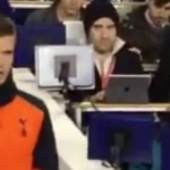Raheem Sterling is just 22. It’s worth repeating because whenever Sterling is discussed, the implication is of an older player. That might be because the morale-sapping sagas, the acrimony which followed his transfer from Liverpool and the poisonous tabloid rhetoric with which he’s often attacked, together, give the impression of something which had no beginning.
But 22. Still developing, still learning, still some way from being whatever he might become.
A glance at Sterling’s statline tells you his form is peaking. Seven goals and two assists from five league starts shows him in rude health and as one of the main beneficiaries of Manchester City’s upswing. Pep Guardiola’s team are playing the most attractive, most diverse and most penetrative football in the country and City’s phalanx of attacking stars are gorging themselves on the resulting chaos. At home they’re utterly dominant and away from the Etihad they have the belligerent swagger of a Viking army, taking no prisoners and burning everything to the ground.
Sterling’s evolution within that context is fascinating. For a long time, he’s been considered solely as a dynamic footballer, the sort who uses his footwork and acceleration to stand opponents up and burst past them. That was his assumed limit.
In fact, it wasn’t so long ago that Joey Barton, joining in gleefully with another public flogging, claimed that Sterling wouldn’t even have made it as a professional were it not been for his athleticism. Barton enjoys playing the antagonist, so it’s hard to know when he’s being sincere, but that was certainly representative of a majority opinion. Sterling has rarely been discussed with any nuance and is more commonly seen as an appendix of a success - the kind of player who dances in the background of more talented teammates. And that would be an easy scenario to depict here, too.
What’s interesting, though, is the regularity with which he scores simple goals. Or, more precisely, how often he’s in a position to score them and what that says about his development as a footballer. While Guardiola is often portrayed as the ultimate evangelist, a head coach who improves everything he touches, his style of football isn’t universally accessible.
Zlatan Ibrahimovic, of course, struggled to cope in a world in which he wasn’t the centrepiece and the talented Alexander Hleb, such an asset to Arsenal and so obviously highly talented, famously struggled emotionally and intellectually while under the Catalan’s watch at Barcelona. By contrast, Sterling is thriving and showing the benefits of a player understanding his role.
Guardiola’s football creates fractures. The way his teams use possession is designed to contort and twist an opponent’s shape and keep them perpetually off-balance. Within that analogy, the final balls - often in the past played by Xavi Hernandez, Andres Iniesta and Leo Messi, and now Kevin De Bruyne, David Silva or Leroy Sane - are the daggers. The thrusts into unguarded flesh.
In a strictly football sense, the final part of that process relies on movement. Penetration of a penalty box is only ever as successful as the activity inside it allows it to be; that’s likely why, underneath the headliners, Guardiola’s teams have always had a layer of highly-productive, secondary stars. Think Pedro Rodriguez at Barcelona, for instance, and remember the types of goal he would typically score. They would depend on movement, on anticipation, on arriving at the right place at the right time at the end of what were often highly complex, multi-pass moves.
The tempting description is “system player”, troublingly derisory though that sounds. The sort who fulfils an important tactical function, who is very much part of the initial build-up stages and the initial murmurs of pressure, and yet who also has the instinct to ruthlessly punish a defence when it inevitably becomes dizzy.
Sterling belongs in that category now. While the upturn in his form is often assessed as a literal and physical improvement, one animated by greater confidence and better conditioning, the more pertinent change is likely intellectual.
Scoring the kind of goals he currently is certainly depends on a degree of ad-libbed movement, but also relies on a developed understanding for what is supposed to happen. What the overall aims of a tactical approach are, for instance, or what its effect is likely to be on a set of opposing players. It’s read and react stuff to a degree, but that Sterling is profiting so heavily suggests his cerebral adaptation to Guardiola has been quicker and more complete than most.















